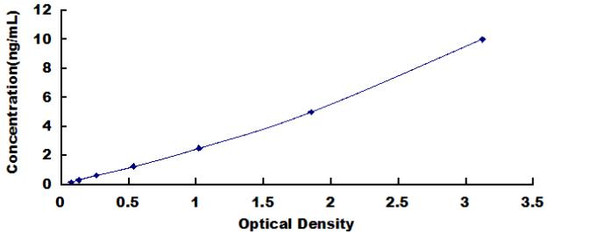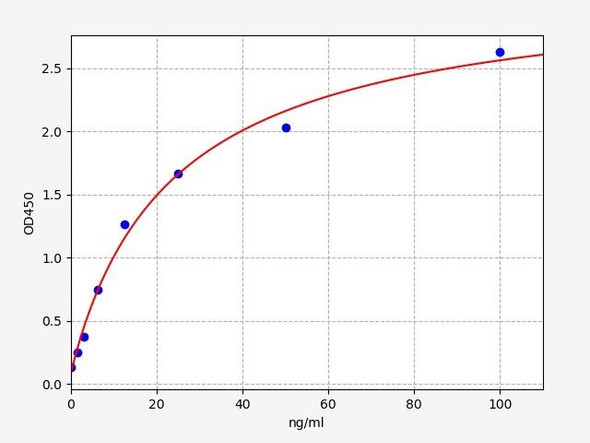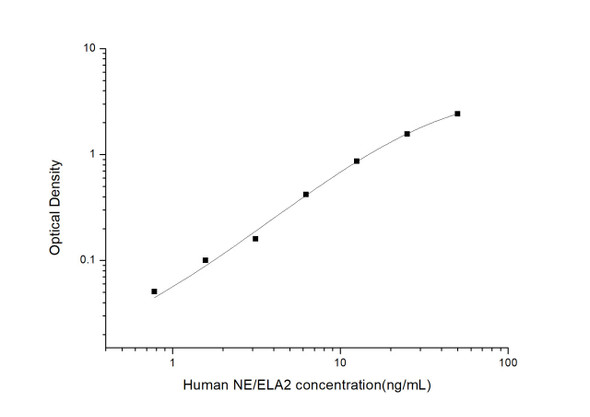Human ELA2 / Neutrophil Elastase ELISA Kit
- SKU:
- HUFI00537
- Product Type:
- ELISA Kit
- Size:
- 96 Assays
- Uniprot:
- P08246
- Sensitivity:
- 0.188ng/ml
- Range:
- 0.313-20ng/ml
- ELISA Type:
- Sandwich
- Synonyms:
- NE, ELA2, ELANE, Elastase-2, Leukocyte Elastase, Medullasin, Bone marrow serine protease, ELA2granulocyte-derived elastase, elastase 2, neutrophil, elastase, neutrophil expressed, Elastase-2, GE, HLEelastase-2, HNE, Human leukocyte elastase, leukocyt
- Reactivity:
- Human
- Research Area:
- Immunology
Description
Human ELA2 / Neutrophil Elastase ELISA
ELANE (Elastase, Neutrophil Expressed) is a Protein Coding gene. Diseases associated with ELANE include Cyclic Neutropenia and Neutropenia, Severe Congenital, 1, Autosomal Dominant. GO annotations related to ELANE include calcium ion binding and gamma-secretase complex disassembly. An important paralog of ELANE is TMPRSS2. ELANE encodes a member of the peptidase M16 family, whose members are known to be involved in degradation of ubiquitinated proteins.
| Product Name: | Human ELA2 / Neutrophil Elastase ELISA Kit |
| Product Code: | HUFI00537 |
| Size: | 96 Assays |
| Alias: | NE, ELA2, ELANE, Elastase-2, Leukocyte Elastase, Medullasin, Bone marrow serine protease, ELA2granulocyte-derived elastase, elastase 2, neutrophil, elastase, neutrophil expressed, Elastase-2, GE, HLEelastase-2, HNE, Human leukocyte elastase, leukocyte elastase, medullasin, Medullasin, NE, neutrophil elastase, PMN elastase, PMN-E, polymorphonuclear elastase, SCN1 |
| Detection method: | Sandwich ELISA, Double Antibody |
| Application: | This immunoassay kit allows for the in vitro quantitative determination of Human ELANE concentrations in serum plasma and other biological fluids. |
| Sensitivity: | 0.188ng/ml |
| Range: | 0.313-20ng/ml |
| Storage: | 4°C for 6 months |
| Note: | For Research Use Only |
| Recovery: | Matrices listed below were spiked with certain level of Human ELANE and the recovery rates were calculated by comparing the measured value to the expected amount of Human ELANE in samples. | ||||||||||||||||
| |||||||||||||||||
| Linearity: | The linearity of the kit was assayed by testing samples spiked with appropriate concentration of Human ELANE and their serial dilutions. The results were demonstrated by the percentage of calculated concentration to the expected. | ||||||||||||||||
| |||||||||||||||||
| CV(%): | Intra-Assay: CV<8% Inter-Assay: CV<10% |
| Component | Quantity | Storage |
| ELISA Microplate (Dismountable) | 8×12 strips | 4°C for 6 months |
| Lyophilized Standard | 2 | 4°C/-20°C |
| Sample/Standard Dilution Buffer | 20ml | 4°C |
| Biotin-labeled Antibody(Concentrated) | 120ul | 4°C (Protect from light) |
| Antibody Dilution Buffer | 10ml | 4°C |
| HRP-Streptavidin Conjugate(SABC) | 120ul | 4°C (Protect from light) |
| SABC Dilution Buffer | 10ml | 4°C |
| TMB Substrate | 10ml | 4°C (Protect from light) |
| Stop Solution | 10ml | 4°C |
| Wash Buffer(25X) | 30ml | 4°C |
| Plate Sealer | 5 | - |
Other materials and equipment required:
- Microplate reader with 450 nm wavelength filter
- Multichannel Pipette, Pipette, microcentrifuge tubes and disposable pipette tips
- Incubator
- Deionized or distilled water
- Absorbent paper
- Buffer resevoir
| Uniprot | P08246 |
| UniProt Protein Function: | ELANE: Modifies the functions of natural killer cells, monocytes and granulocytes. Inhibits C5a-dependent neutrophil enzyme release and chemotaxis. Defects in ELANE are a cause of cyclic haematopoiesis (CH); also known as cyclic neutropenia. CH is an autosomal dominant disease in which blood-cell production from the bone marrow oscillates with 21-day periodicity. Circulating neutrophils vary between almost normal numbers and zero. During intervals of neutropenia, affected individuals are at risk for opportunistic infection. Monocytes, platelets, lymphocytes and reticulocytes also cycle with the same frequency. Defects in ELANE are the cause of neutropenia severe congenital autosomal dominant type 1 (SCN1). SCN1 is a disorder of hematopoiesis characterized by a maturation arrest of granulopoiesis at the level of promyelocytes with peripheral blood absolute neutrophil counts below 0.5 x 10(9)/l and early onset of severe bacterial infections. Belongs to the peptidase S1 family. Elastase subfamily. |
| UniProt Protein Details: | Protein type:Motility/polarity/chemotaxis; Cell cycle regulation; Cell surface; Protease; EC 3.4.21.37 Chromosomal Location of Human Ortholog: 19p13.3 Cellular Component: cell surface; transcriptional repressor complex; cytoplasm; extracellular region; secretory granule Molecular Function:heparin binding; peptidase activity; protein binding; protease binding; cytokine binding; serine-type endopeptidase activity; endopeptidase activity Biological Process: extracellular matrix organization and biogenesis; positive regulation of immune response; positive regulation of smooth muscle cell proliferation; negative regulation of interleukin-8 biosynthetic process; positive regulation of interleukin-8 biosynthetic process; response to lipopolysaccharide; negative regulation of chemotaxis; negative regulation of transcription from RNA polymerase II promoter; proteolysis; phagocytosis; cellular calcium ion homeostasis; positive regulation of MAP kinase activity; extracellular matrix disassembly; collagen catabolic process; negative regulation of inflammatory response; defense response to bacterium; protein catabolic process; response to yeast; leukocyte migration; acute inflammatory response to antigenic stimulus; response to UV; negative regulation of chemokine biosynthetic process Disease: Cyclic Neutropenia; Neutropenia, Severe Congenital, 1, Autosomal Dominant |
| NCBI Summary: | Elastases form a subfamily of serine proteases that hydrolyze many proteins in addition to elastin. Humans have six elastase genes which encode the structurally similar proteins. The product of this gene hydrolyzes proteins within specialized neutrophil lysosomes, called azurophil granules, as well as proteins of the extracellular matrix following the protein's release from activated neutrophils. The enzyme may play a role in degenerative and inflammatory diseases by its proteolysis of collagen-IV and elastin of the extracellular matrix. This protein degrades the outer membrane protein A (OmpA) of E. coli as well as the virulence factors of such bacteria as Shigella, Salmonella and Yersinia. Mutations in this gene are associated with cyclic neutropenia and severe congenital neutropenia (SCN). This gene is clustered with other serine protease gene family members, azurocidin 1 and proteinase 3 genes, at chromosome 19pter. All 3 genes are expressed coordinately and their protein products are packaged together into azurophil granules during neutrophil differentiation. [provided by RefSeq, May 2009] |
| UniProt Code: | P08246 |
| NCBI GenInfo Identifier: | 119292 |
| NCBI Gene ID: | 1991 |
| NCBI Accession: | P08246.1 |
| UniProt Secondary Accession: | P08246,P09649, Q6B0D9, Q6LDP5, |
| UniProt Related Accession: | P08246 |
| Molecular Weight: | 28,518 Da |
| NCBI Full Name: | Neutrophil elastase |
| NCBI Synonym Full Names: | elastase, neutrophil expressed |
| NCBI Official Symbol: | ELANE |
| NCBI Official Synonym Symbols: | GE; NE; HLE; HNE; ELA2; SCN1; PMN-E |
| NCBI Protein Information: | neutrophil elastase; elastase-2; medullasin; PMN elastase; leukocyte elastase; elastase 2, neutrophil; human leukocyte elastase; polymorphonuclear elastase; bone marrow serine protease; granulocyte-derived elastase |
| UniProt Protein Name: | Neutrophil elastase |
| UniProt Synonym Protein Names: | Bone marrow serine protease; Elastase-2; Human leukocyte elastase; HLE; Medullasin; PMN elastase |
| Protein Family: | Elastase |
| UniProt Gene Name: | ELANE |
| UniProt Entry Name: | ELNE_HUMAN |
*Note: Protocols are specific to each batch/lot. For the correct instructions please follow the protocol included in your kit.
Before adding to wells, equilibrate the SABC working solution and TMB substrate for at least 30 min at 37°C. When diluting samples and reagents, they must be mixed completely and evenly. It is recommended to plot a standard curve for each test.
| Step | Protocol |
| 1. | Set standard, test sample and control (zero) wells on the pre-coated plate respectively, and then, record their positions. It is recommended to measure each standard and sample in duplicate. Wash plate 2 times before adding standard, sample and control (zero) wells! |
| 2. | Aliquot 0.1ml standard solutions into the standard wells. |
| 3. | Add 0.1 ml of Sample / Standard dilution buffer into the control (zero) well. |
| 4. | Add 0.1 ml of properly diluted sample ( Human serum, plasma, tissue homogenates and other biological fluids.) into test sample wells. |
| 5. | Seal the plate with a cover and incubate at 37 °C for 90 min. |
| 6. | Remove the cover and discard the plate content, clap the plate on the absorbent filter papers or other absorbent material. Do NOT let the wells completely dry at any time. Wash plate X2. |
| 7. | Add 0.1 ml of Biotin- detection antibody working solution into the above wells (standard, test sample & zero wells). Add the solution at the bottom of each well without touching the side wall. |
| 8. | Seal the plate with a cover and incubate at 37°C for 60 min. |
| 9. | Remove the cover, and wash plate 3 times with Wash buffer. Let wash buffer rest in wells for 1 min between each wash. |
| 10. | Add 0.1 ml of SABC working solution into each well, cover the plate and incubate at 37°C for 30 min. |
| 11. | Remove the cover and wash plate 5 times with Wash buffer, and each time let the wash buffer stay in the wells for 1-2 min. |
| 12. | Add 90 µl of TMB substrate into each well, cover the plate and incubate at 37°C in dark within 10-20 min. (Note: This incubation time is for reference use only, the optimal time should be determined by end user.) And the shades of blue can be seen in the first 3-4 wells (with most concentrated standard solutions), the other wells show no obvious color. |
| 13. | Add 50 µl of Stop solution into each well and mix thoroughly. The color changes into yellow immediately. |
| 14. | Read the O.D. absorbance at 450 nm in a microplate reader immediately after adding the stop solution. |
When carrying out an ELISA assay it is important to prepare your samples in order to achieve the best possible results. Below we have a list of procedures for the preparation of samples for different sample types.
| Sample Type | Protocol |
| Serum | If using serum separator tubes, allow samples to clot for 30 minutes at room temperature. Centrifuge for 10 minutes at 1,000x g. Collect the serum fraction and assay promptly or aliquot and store the samples at -80°C. Avoid multiple freeze-thaw cycles. If serum separator tubes are not being used, allow samples to clot overnight at 2-8°C. Centrifuge for 10 minutes at 1,000x g. Remove serum and assay promptly or aliquot and store the samples at -80°C. Avoid multiple freeze-thaw cycles. |
| Plasma | Collect plasma using EDTA or heparin as an anticoagulant. Centrifuge samples at 4°C for 15 mins at 1000 × g within 30 mins of collection. Collect the plasma fraction and assay promptly or aliquot and store the samples at -80°C. Avoid multiple freeze-thaw cycles. Note: Over haemolysed samples are not suitable for use with this kit. |
| Urine & Cerebrospinal Fluid | Collect the urine (mid-stream) in a sterile container, centrifuge for 20 mins at 2000-3000 rpm. Remove supernatant and assay immediately. If any precipitation is detected, repeat the centrifugation step. A similar protocol can be used for cerebrospinal fluid. |
| Cell culture supernatant | Collect the cell culture media by pipette, followed by centrifugation at 4°C for 20 mins at 1500 rpm. Collect the clear supernatant and assay immediately. |
| Cell lysates | Solubilize cells in lysis buffer and allow to sit on ice for 30 minutes. Centrifuge tubes at 14,000 x g for 5 minutes to remove insoluble material. Aliquot the supernatant into a new tube and discard the remaining whole cell extract. Quantify total protein concentration using a total protein assay. Assay immediately or aliquot and store at ≤ -20 °C. |
| Tissue homogenates | The preparation of tissue homogenates will vary depending upon tissue type. Rinse tissue with 1X PBS to remove excess blood & homogenize in 20ml of 1X PBS (including protease inhibitors) and store overnight at ≤ -20°C. Two freeze-thaw cycles are required to break the cell membranes. To further disrupt the cell membranes you can sonicate the samples. Centrifuge homogenates for 5 mins at 5000xg. Remove the supernatant and assay immediately or aliquot and store at -20°C or -80°C. |
| Tissue lysates | Rinse tissue with PBS, cut into 1-2 mm pieces, and homogenize with a tissue homogenizer in PBS. Add an equal volume of RIPA buffer containing protease inhibitors and lyse tissues at room temperature for 30 minutes with gentle agitation. Centrifuge to remove debris. Quantify total protein concentration using a total protein assay. Assay immediately or aliquot and store at ≤ -20 °C. |
| Breast Milk | Collect milk samples and centrifuge at 10,000 x g for 60 min at 4°C. Aliquot the supernatant and assay. For long term use, store samples at -80°C. Minimize freeze/thaw cycles. |
Fill out our quote form below and a dedicated member of staff will get back to you within one working day!






